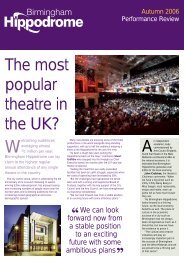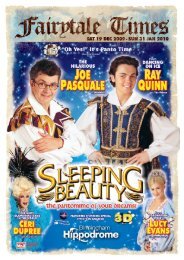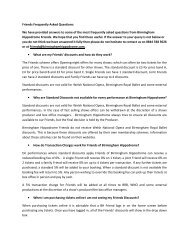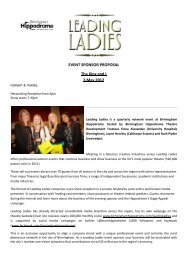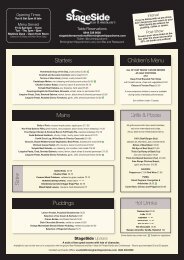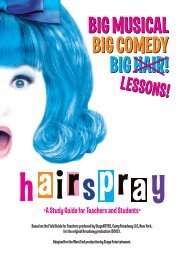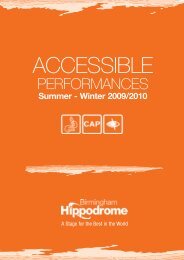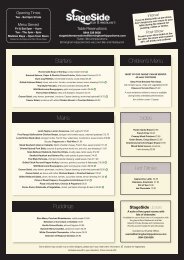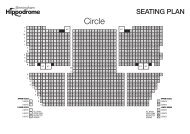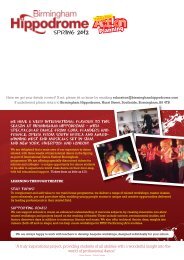REVELATIONS - Birmingham Hippodrome
REVELATIONS - Birmingham Hippodrome
REVELATIONS - Birmingham Hippodrome
Create successful ePaper yourself
Turn your PDF publications into a flip-book with our unique Google optimized e-Paper software.
<strong>REVELATIONS</strong>(1960)Choreography by Alvin AileyMusic: TraditionalDécor and Costumes by Ves HarperCostumes for “Rocka My Soul” redesigned by Barbara ForbesLighting by Nicola CernovitchAlvin Ailey American Dance Theater Company MembersPhoto by Andrew EcclesThe young genius Alvin Ailey was only 29 years old when he created his most significant cultural masterpiece,Revelations, to spirituals in 1960. It is astonishing that this was only the tenth ballet choreographed by Mr. Ailey. Ailey’sinspiration for creating Revelations came from a variety of sources: memories of attending Baptist services in Texas as achild, interest in Brueghal’s paintings, Oriental Theater and his acquaintances with African-American writers JamesBaldwin and Langston Hughes.Since then, more people around the world have seen this modern dance classic than any other work. Audiences still leavetheir seats jumping and screaming. It seems only appropriate to celebrate Ailey’s masterwork by hearing from the creatorhimself about the genesis of this legacy.-“Revelations began with the music. As early as I can remember I was enthralled by the music played and sung in the smallblack churches in every small Texas town my mother and I lived in. No matter where we were during those nomadic years,Sunday was always a churchgoing day. There we would absorb some of the most glorious singing to be heard anywhere in theworld.-“With profound feeling, with faith, hope, joy and sometimes sadness, the choirs, congregations, deacons, preachers and usherswould sing black spirituals and gospel songs. They sang and played the music with such fervor that even as a small child I couldnot only hear it but almost see it. I remember hearing “Wade in the Water” being sung during a baptism and hearing the pastor’swife sing “I Been Buked, I Been Scorned” one Sunday during testifying time. I tried to put all of the feeling into Revelations.“My plan was to make Revelations the second part of an all-black evening of dance. First would be the blues in Blues Suite,then spirituals in Revelations, then a section on Kansas City jazz [and] a section of contemporary music. The aim was to showthe coming and the growth and reach of black culture.“I did extensive research, listened to a lot of music, dug even deeper into my early Texas memories and came up with the piecethat I would call Revelations. I phoned Hall Johnson, a wonderful man who lived uptown and said, ‘We want to do this dancetwo to three months from now from all these spirituals. I would like for you to sing.’ He had a choir and led me to a lot of
music, including “I Been Buked, I Been Scorned,” which I didn’t know that he had arranged. He decided not to do the concert,and I ended up with a group from the YMCA in Harlem. One way or another, I had to have live music; for me there was noother way.“I divided an hour of these pieces into three sections. First I did it chronologically, leading off with the opening part ofRevelations, which was the earliest in time. It was about trying to get up out of the ground. The costumes and the set would becolored brown, an earth color, for coming out of the earth, for going into the earth. The second part was something that wasvery close to me- the baptismal, the purification rite. Its colors would be white and pale blue. Then there would be the sectionsurrounding the gospel church, the holy rollers and all the church happiness. Its colors would be earth tones, yellow and black.“At the time I was very involved with the work of the sculptor Henry Moore. Lester [Horton, Ailey’s mentor] had admired himtoo; I guess I picked up my love of Moore from him. I liked the way Moore’s figures were abstracted, stretched, strained andpulled. His work inspired the costumes made of jersey in the first part of Revelations. When the body moves, the jersey takes onextraordinary tensions.“The first version of Revelations was quite long - an hour and five minutes - and it had three sections. The first was called“Pilgrim of Sorrow.” I took all of the songs dealing with black people’s sorrow and put them in this section; at the time therewere about five or six songs. The middle section was to be “Wading in the Water. ”Songs such as “Honor, Honor” had all ofthese extraordinary words. I was moved by what spirituals say as words, as metaphors. So I found these short songs for themiddle section.“There were quite a few songs for the last section, “Move Members, Move.” The whole ballet was a gigantic suite of spirituals.I poured in just about everything, every beautiful spiritual I had ever heard. From the beginning I thought the first version ofRevelations might be too long, but nobody ever complained about the length. The critics and audiences had nothing but themost delicious praise from the beginning.“Revelations didn’t reach its real popularity until it was edited. After I snipped, cut, pushed and pulled Revelations down to ahalf hour. It’s pretty clear that there is a love affair between audiences and Revelations. The idea of producing spirituals onsuch a grand scale appealed to everyone. It had beautiful songs by a live soloist. Revelations was long, but people alwaysresponded enthusiastically to every song and every movement by the dancers.“When we performed Revelations in Athens at the Herod Atticus, an amphitheater with six thousand seats, every [seat] wasfilled. It was an unforgettable experience to hear that many people screaming for twenty minutes at the curtain. They just lovedthe music; they were totally into it and that happens all over the world with this work. We had a big success in Russia, where allthe rhythm and hand clapping is an integral part to their folk dances.“The last time we were in Paris, five thousand people clapped, stomped and screamed until we had to do two encores. TheGermans and Italians, too, fell in love with Revelations. In fact, we always close with Revelations in Europe. I think the StateDepartment invited us to go on tour in Southeast Asia in 1962 in part because of the universal popularity of the music inRevelations. I heard Indonesian music that sounded very much like the blues; I heard Burmese music that sounded very muchlike spirituals. The French have their spirituals. The tune and texture of the spirituals speak to everybody.“I’m not afraid to say there’s not one song in Revelations that doesn’t hold the listener’s interest. The songs are poetic, and therhythm that grows out of them is black rhythm. The songs are truthful and a real coming together of music and ideas throughdance. The songs also represent a coming together of many things in my head – of youthful energy and enthusiasm, of myconcern about projecting the black image properly. They reflect my own feelings about being pressed into the ground of Texas;they recreate the music I heard from ladies in Texas who sold apples while singing spirituals, memories of songs my motherwould hum around the house and the songs I sang in junior high school. We would sing “Rocka My Soul” in my junior highglee club. The songs in Revelations are all those things. And I think they have meant a lot to audiences everywhere.“One of the promises of my company is that its repertoire will include pieces that ordinary people can understand. I still dreamthat my folks down on the farm in Texas can come to an Ailey concert and know and appreciate what is happening onstage.That’s my perception of what dance should be – a popular form wrenched from the elite.”We rejoice at this amazing celebration, for the memory of Mr. Ailey, for Judith Jamison and for all the exquisite Aileydancers who continually dance in the spirit of the great Alvin Ailey.



